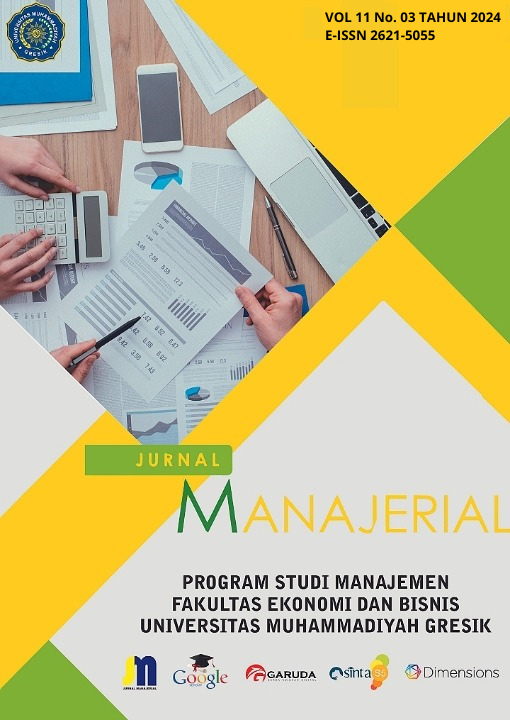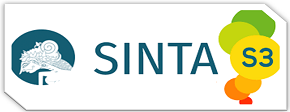Pengukuran Beban Kerja Mental Mahasiswa Pekerja Fakultas Ekonomi Dan Bisnis Universitas Muhammadiyah Gresik Menggunakan Metode Nasa-TLX
DOI:
https://doi.org/10.30587/jurnalmanajerial.v11i03.7700Keywords:
Workload, Mental, Student WorkersAbstract
Background – Mental workload is the difference between the workload demands of a task and capacity. Mental workload is a human evaluation or assessment of the limits of attentional load while carrying out tasks optimally, which is influenced by the workload demands of a task and the worker's capacity to handle the task, especially for students who carry out work activities while studying. Therefore, it is necessary to examine how much mental workload is actually borne by student workers so that the negative impacts it causes can be minimized.
Aim – To measure the mental workload of student workers at the Faculty of Economics and Business, Muhammadiyah University of Gresik using the NASA-TLX method
Design / methodology / approach – The research approach used is Quantitative Descriptive. Quantitative data was obtained from the results of questionnaire responses from student workers at the Faculty of Economics and Business, Muhammadiyah University of Gresik regarding the level of mental workload using the NASA-TLX method.
Findings – High mental workload can have a negative impact on a person's mental health, especially for students who work while studying. Mental workload is defined as the difference between task demands and an individual's capacity to handle the task, focusing more on the mental aspect than the physical. Students who work while studying often experience fatigue, lack of time to rest and socialize, and experience sleep disorders and stress which can reduce their academic and work performance. Therefore, it is important to measure and analyze the level of mental workload experienced by student workers in order to reduce its negative impact. The method used to measure mental workload is NASA-TLX (Task Load Index).
Conclusion – Student workers at the Faculty of Economics and Business, Muhammadiyah University of Gresik experience a high mental workload, with the time demand indicator (Temporal Demand/TD) having the highest weight and the level of effort (Effort/EF) getting the highest score. The time requirement (TD) indicator most dominantly influences their mental workload, while the level of frustration (FR) has the lowest influence. Overall, their average mental workload score was in the high category, namely 77.64.
Research implication – This research is aimed at students who are studying while working, with the aim of measuring the level of mental load that objects experience. The load in question is a high mental workload, with indicators of time requirements (Temporal Demand/TD), level of effort (Effort/EF) and indicators of time requirements (TD), as well as levels of frustration (Frustration/FR).
Limitations – The limitations of this research only include the mental workload variable on the research object (student workers)
References
Hart, S. G., & Staveland, L. E. 1988. Development of NASA-TLX (Task Load Index): Results of empirical and theoretical research. In Advances in psychology (Vol. 52, pp. 139-183). North-Holland
Henry. R. Jex. (1988). “Advance in Psychlogy Human Mental Workload”. Elsevier Science Publisher B.V: North Holland.
Hutabarat, S. dan Evan S.M. 2018 . Pengantar Oseanografi. Jakarta. UI Press
Mahmud, R., & Uyun, Z. 2016. Studi Deskriptif Mengenai Pola Stress Pada Mahasiswa Praktikum. Jurnal Idigineous, 1(2) , 52-61.
Pieper, J. dan Uden, M.V. (2006). Religion in Coping and Mental Health Care. New York: Yord University Press, Inc.
Simanjuntak, A. R., & Situmorang, A. D. (2010). Analisis Pengaruh Shift Kerja Terhadap Beban Kerja Mental dengan Metode Subjective Workload Assessment Technique (SWAT). Jurnal Teknologi, 53-60.
Sugiyono. (2016). Statistika untuk Penelitian. Bandung: Alfabeta.
Susilowati. (1999). Analisis Beban Kerja Mental dengan menggunakan Metode NASA-TLX.
Ward, De Dick. (1996). The Measurement Of Drivers' Mental Workload. s.n. University of Groningen.
Widyanti, A. dkk. (2010). Pengukuran Beban Kerja Mental Dalam Searching Task Dengan Metode Rating Score Mental Effort (RSME). Bandung: Teknik Industri ITB.






























 P-ISSN: 2354-8592 __ E-ISSN: 2621-5055
P-ISSN: 2354-8592 __ E-ISSN: 2621-5055 
